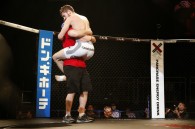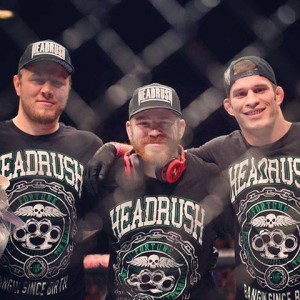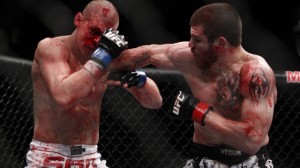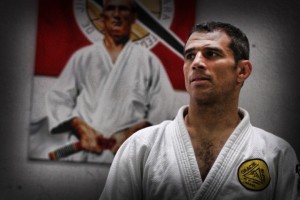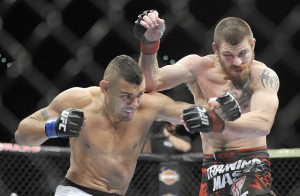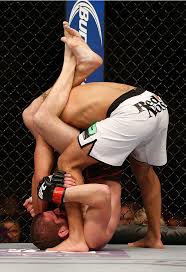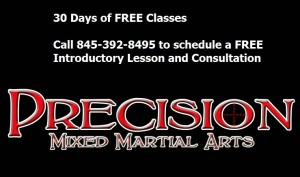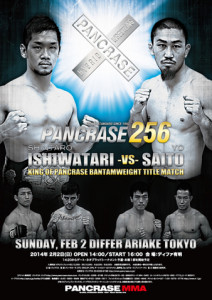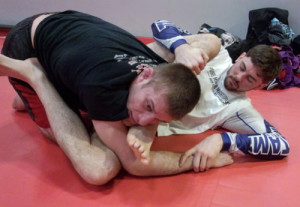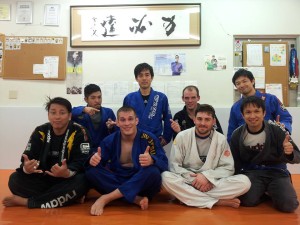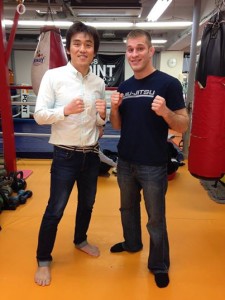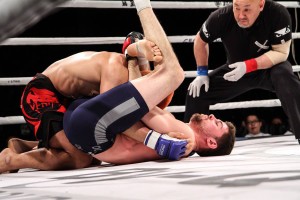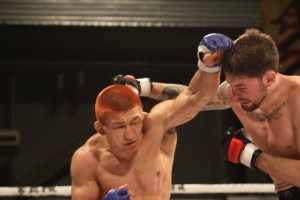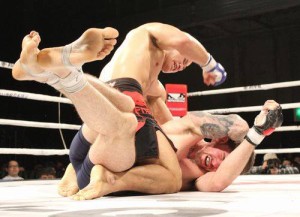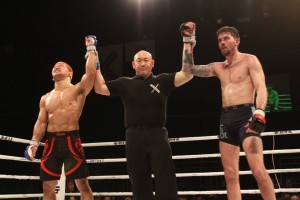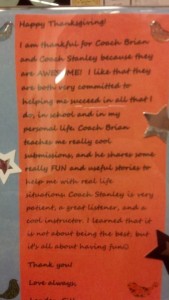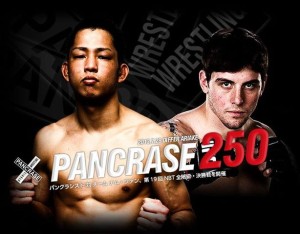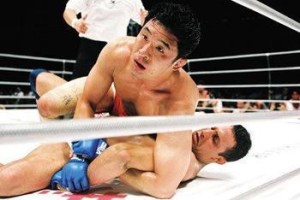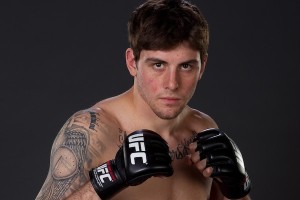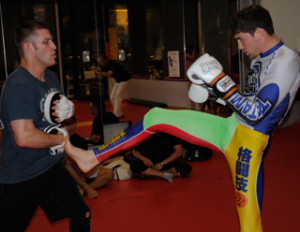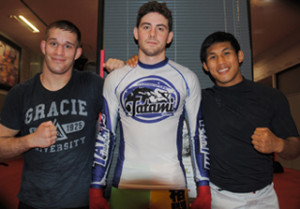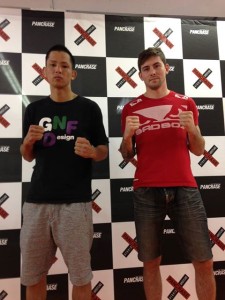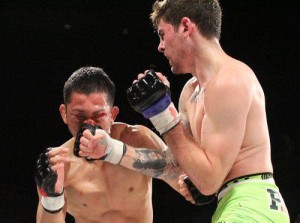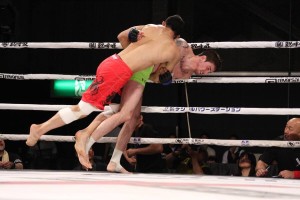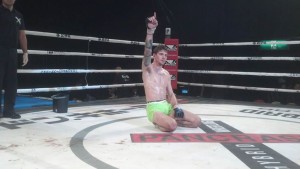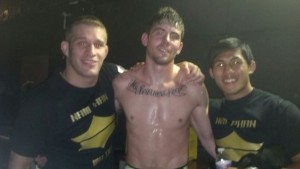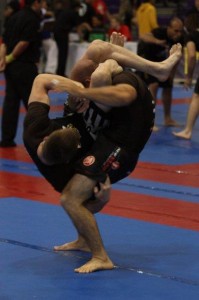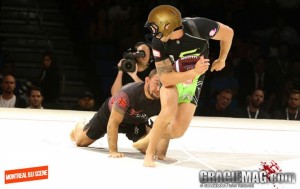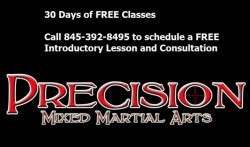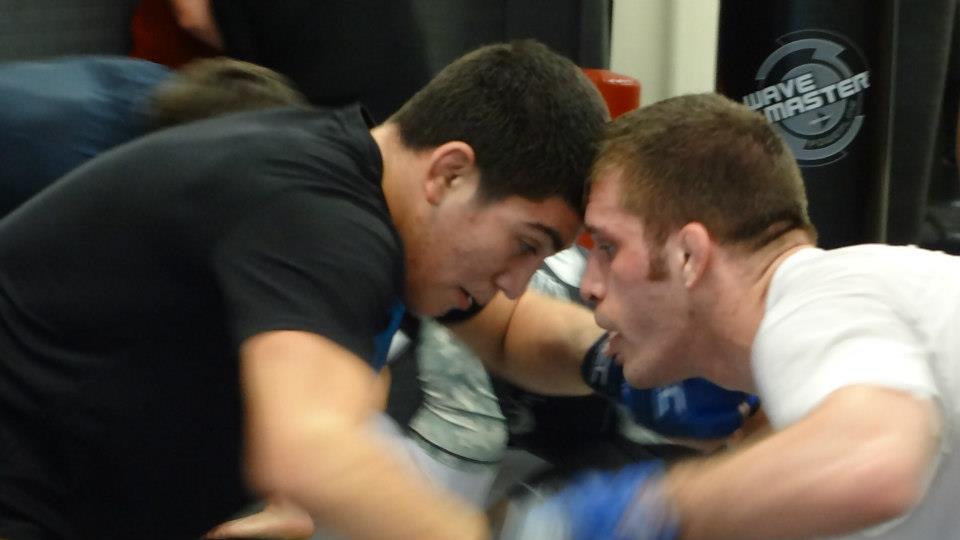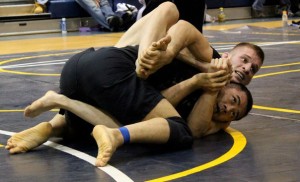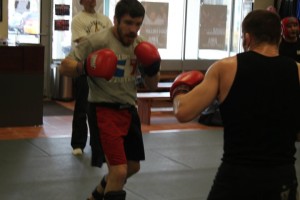My thoughts on how training jiu-jitsu gives you a realistic sense of self
In Your Corner
The fighters I train are really a special breed. Their discipline, sacrifice and passion inspire in all aspects of my life. There is no greater group of human beings I could ever hope to corner
Precision MMA at UFC 168 – It’s Miller Time
A long time ago in a galaxy far, far away I first met Jim and Dan Miller – it was around 2005 at “Planet Jiu-jitsu” (the name of the gym where the Miller’s began their training). Planet was an affiliate of my coach Rob Kahn and he brought me along to roll with these two blue belts everyone was talking about. I knew they both were standout wrestlers, but knowing these prodigies hadn’t been training very long I didn’t expect much. Despite their limited mat time Jim and Dan gave me all I could handle – the only reason I was able to come out on top at all was because I used submissions they hadn’t seen yet. Afterwards we all went out to eat and they told me how they were training for their first MMA fights in a few weeks. I immediately knew they would quickly be making a name for themselves.
Eventually Sean “Shorty Rock” Santella started asking me to work with him. He took to my teaching well and began singing my praises enough that a few other fighters started trying me on for size – eventually I wound up working with the Millers. Jim and Dan are special athletes. For most people, they’ll learn a new move or concept and it will take a serious amount of repetition along with trial and error before they make it their own. With the Millers, I could show them a technique on Monday and they’d tap me out with it by Wednesday. Jim and Dan are submission hunters, we used to joke that they had a “submission before position” style of fighting. This sort of approach has earned them more than a few bonus checks and some amazing highlight reel finishes, but from time to time it could backfire.
In Jim’s bouts against Joe Lauzon and Pat Healy he went full seek and destroy mode right out the gate. He left Lauzon covered in blood and had Healy nearly unconscious at the end of the first round. However, as the fights played out both turned into back and forth wars – while the FOTN bonus checks were nice it was becoming apparent that a more tactical approach might result in a longer and more fruitful career. Going into this fight camp all coaches were in agreement about being efficient and calculating; hitting single and doubles rather than constantly swinging for the fences. The ground attack for based around safety first, making sure to avoid unnecessary damage and allowing the opponent to give us the opening rather than forcing it. Jim’s opponent Fabricio Camoes was a 3rd degree BJJ black belt so we had our work cut out for us.
This was my first time cornering a fight in Vegas. I didn’t realize how intense the fight fans were. Jim was a full-fledged celebrity, every step he took he was shaking hands, signing autographs or kissing babies. More people knew Jim here than if he was at his high school reunion. The interesting thing I noticed though was how short the fan’s memories were. After leaving a fighter meeting I walked ahead while Jim was meeting with fans. Standing next to me the entire time was former world champion Mike Brown. To me Brown is an MMA legend; he finished Urijah Faber when many thought he was untouchable. Before Jose Aldo came along he had won 10 straight and was a two time defending WEC champion. Still and active fighter, he had won 2 of his last 3 UFC fights. Yet he walked through the crowded sea of fans without recognition. I came to realize that MMA is very much about “what have you done lately”.
Team Miller passed the time telling stories about youthful hijinks, gardening and brewing strategies and the many misadventures of their precocious children. Aside from briefly discussing strategy you’d have no idea we would be entering a fist fight on pay per view.
I’m generally very nervous before fights. Regardless of how prepared a fighter happens to be I can’t keep my mind from running through doomsday scenarios. I generally try to conceal my uncertainty through a combination of binge eating and bad jokes. For this fight I felt abnormally at ease. I was certain Jim would be successful and his confident disposition calmed my normally alert nerves. However, for a moment all that changed. While at weigh-ins I saw Royler Gracie stroll by and thought to myself, “I wonder who he’s cornering”. Then I remembered that he was there for Camoes, Jim’s opponent. I had a sudden bout of self-doubt. I grew up on legends of the Gracie family. When I was 16 you could have convinced me that Helio and his sons hung the moon. I remember Royler was hand-picked to corner Rickson in Japan years before I even knew how to spell jiu-jitsu. I thought he had likely forgotten more than I’d ever know about jiu-jitsu. However, for the past two months I was tasked with devising a jiu-jitsu strategy that would overwhelm Royler’s top fighter. My dormant neurosis was now alive and well. I reminded myself that it was Jim vs Camoes, not Brian vs Royler and tried my best to focus on the task at hand.
This fight camp there was a new approach. Jim took a more analytical approach to his preparation and really put himself under the microscope. He realized that while he had elite technique and conditioning, he would occasionally get himself into hot water by being overly aggressive. Trying to KO his opponent with every strike earned him some hefty bonuses, but may have cost him some key victories as well. Patience and relaxation were the theme of this fight camp. Attack when the moment is right rather than forcing the issue. Warming up Jim looked fluid and focused. When the first note of “Long Cool Woman” filled the arena Jim marched towards the octagon with unshakable composure.
The bell sounded and Camoes rushed towards Jim. While our approach was slow and steady, Camoes was in seek and destroy mode. The first few exchanges saw Camoes landing hard strikes that were starting to find their mark. He was loading up on hooks and head kicks, trying to end the bout quickly. This was not what we expected. A wrestling and jiu-jitsu attack was what we assumed Camoes, a third degree BJJ black belt, would bring to the table. This straight ahead striking attack took us by surprise. Jim shifted gears and looked for the takedown, which presented itself when Camoes attempted a high kick. Immediately Camoes attempted to spring back to his feet and in the process exposed his back. Jim got a little overanxious and slid off the back though, ending up on the bottom in guard. Instantly, he began breaking Camoes’ posture in order to control the distance and limit any strikes. I called out for him to swim his arm to the mat. Jim responded, but Camoes countered and kept his arm on the torso. Jim cleared the head and immediately swung into the armbar. He clamped his legs into position and synched a tight grip across the wrist while hooking the leg to prevent a slam. Then he waited. Rather than forcing the issue he was biding his time and waiting for the ideal opportunity. Camoes for a moment pulled his weight back; Jim now had his opportunity and powerfully arched his hips. Dan saw Camoes wince in pain and instructed his brother to give it everything he had. Jim obliged him and Camoes was forced to submit.
Immediate exaltation spread throughout our corner. A first round submission without taking serious damage, by all accounts a near perfect performance. Camoes stormed off, punching the cage in anger. In that moment I felt for him. He had obviously made substantial improvements for this fight. He had hoped to put the new and improved Fabricio Camoes on display and for a few moments looked like he might enjoy his day in the sunshine. However, MMA is a winner-take-all system and despite his diligence he would suffer the slings and arrows of defeat. Following his cathartic fence stomping Camoes shook Jim’s hand.
-During his post-fight interview Jim surprised me. It isn’t often that a fighter gets a captive audience, victory speeches are often opportunities to bolster their accomplishment, proclaim their title worthiness, or call out rival fighters. Instead when Joe Rogan asked Jim about his victory he took his moment to tell the world that I was a quality trainer, a truly selfless act that reminded me that every long drive to New Jersey was well worth the trip.
Looking for elite mixed martial arts, boxing or Brazilian Jiu-Jitsu near Poughkeepsie, NY? Check out Precision MMA for 30 Days Free visit http://www.poughkeepsiemixedmartialarts.com or call 845-392-8495 845-392-8495 to get started
845-392-8495 to get started
Big in Japan – Andy Main and Brian McLaughlin at Pancrase 256 (Precision MMA Pure MMA)
2014 has been busy for me. Although the year is still in its infancy I’ve traveled from Poughkeepsie to Las Vegas, Atlanta, and now Tokyo, along the way sharing in surreal victories and heartbreaking defeats. The mixed martial arts world is a roller coaster of experiences. Fights are by their very nature chaotic and unpredictable. As martial artists we attempt to tame the beast of uncertainty through rigorous training and preparation. Yet, despite our best efforts there are no guarantees and fortunes rise and fall with each punch thrown. Although I’ve often times felt the cold realities of this phenomenon; as I boarded the plane for Tokyo I thought to myself, “we’ve got this in the bag”.
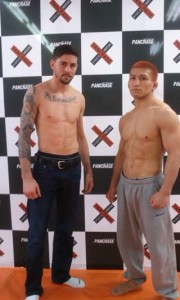 Stepping into the ring was Andy Main, a long and lean southpaw who could tap out most men with a stern glance. He was riding a three fight winning streak, including a victory over Hiroki Aoki, a feared top ten Pancrase fighter. His opponent this time around was Akira Okada. Akira was heralded as the top pupil of Japanese MMA legend Takanori Gomi. Similar to “the fireball kid” Akira earned his victories through vicious power. He’d throw hard and often, and on more than one occasion left his opponent wearing a crimson mask of his own blood. However, his power and fierceness left him wild. A precise fighter like Andy could navigate the turbulent sea of aggression and find many ports to victory. There were other factors on our side as well – Andy was half a foot taller with a sizeable reach advantage. His movements were faster and more dynamic. Akira moved forward in a leaping fashion, Andy’s footwork was sure to leave him lost and confused. Andy had also sharpened his jiu-jitsu, adding new submission entries from his already dangerous guard. Every time I ran the numbers the arithmetic yielded the same result, an Andy Main victory.
Stepping into the ring was Andy Main, a long and lean southpaw who could tap out most men with a stern glance. He was riding a three fight winning streak, including a victory over Hiroki Aoki, a feared top ten Pancrase fighter. His opponent this time around was Akira Okada. Akira was heralded as the top pupil of Japanese MMA legend Takanori Gomi. Similar to “the fireball kid” Akira earned his victories through vicious power. He’d throw hard and often, and on more than one occasion left his opponent wearing a crimson mask of his own blood. However, his power and fierceness left him wild. A precise fighter like Andy could navigate the turbulent sea of aggression and find many ports to victory. There were other factors on our side as well – Andy was half a foot taller with a sizeable reach advantage. His movements were faster and more dynamic. Akira moved forward in a leaping fashion, Andy’s footwork was sure to leave him lost and confused. Andy had also sharpened his jiu-jitsu, adding new submission entries from his already dangerous guard. Every time I ran the numbers the arithmetic yielded the same result, an Andy Main victory.
Boarding the plane felt familiar. Things were going to be easier this time around I thought. We were prepared for the marathon flight and jetlag. We knew where to train and how to traverse the landscape. The ring would be familiar and the unique rules routine. While the lack of novelty was comforting, it also made the experience less magical. We had become well acquainted with Japanese mores; episodes of culture shock were few and far between. This trip was less about exploring a foreign land and more about taking care of business.
After getting settled we went for our fist pre-fight workout. Since Andy was fighting at 155, a weight class above his featherweight home, his energy was high and we were able to train hard. We rolled for close to 30 minutes straight and I had to fight for every inch of progress. Andy’s transitions were sharp and the 15 hours of flight had not robbed him of one ounce of strength. We went over a small handful of techniques and scenarios and then met the media for photo ops and interviews.
Later in the evening I wanted to get some training in so we made a trip to Tri-force Gotanda, a spectacular BJJ school that I had visited during my last trip to Tokyo. We reviewed some Judo throws and then it was time for rolling. I expected Andy to be a bit slower considering our earlier training session, but he was every bit as fast and left his training partners scratching their heads and gasping for air. I knew he was without a doubt in fight shape.
The following day was weigh-ins. I was surprise when I saw MMA legend Yuki Kondo step on the scale. I had no idea he was fighting on the card. Kondo had tooth and nail battles with the likes of Semmy Schilt and Dan Henderson. He famously stopped the MMA hopes of BJJ legend Saulo Ribeiro and even took on Tito Ortiz for the UFC title. Even more amazing was that Andy had higher billing than him on the card. Kondo shook my hand and obliged my requests for photos with admirable humility.
Finally fight day was upon us, we followed the routine of “hurry up and wait”. Pancrase events are marathons with up to 30 bouts on a single card with talent ranging from aspiring new comers to mixed martial arts royalty. Andy was the co-main event, which meant we had some time to kill. We alternated between waxing philosophical about deep existential mysteries of the universe and trading stories about crazy ex-girlfriends.
As fight time approached we rehearsed the gameplan and I went about reassuring Andy of his success (which is as much for me as it is for him). When I heard the familiar sound of his walkout music I knew we’d reached that point of no return and made our way towards the ring. The bell sounded and Akira rushed forward, Andy rattled off a three punch combination finding the mark with each strike. After tasting Andy’s strikes Akira rushed in for the takedown. I could tell Akira’s strength and power were alive and well for this bout. Immediately Andy tied Akira up, taking away all his offensive options. Akira drove his head forward pressuring Andy, but this only made him more vulnerable to attack. Andy shifted his hips and began maneuvering into position for armbars and triangles. After several close calls Akira abandoned all offense and made survival his sole concern. The round came to a conclusion and I assured Andy that his strategy was working, but he’d need to open up more in order to secure the submission. I also noted that Akira had unusually small arms, making the triangle a better option than the armbar. Andy nodded and paced in the corner awaiting the start of the second round. A unique part of Pancrase is their open scoring where fighters know exactly what the judges render after each round. Two judges scored the round even, one judge gave the round to Andy; making us ahead by the smallest of margins.
Akira was aware he was behind and the threat of defeat clearly awakened a dormant sense of urgency in him. The echo of the bell was still in the air when Akira leapt forward with a thunderous punch. The shot landed flush but Andy clinched and fired back a knee. They were chest to chest now, which negated Andy’s reach advantage and gave Akira the window he had been waiting for. Akira fired off rapid fire hooks, uppercuts and knees finding their mark over and over again. Andy was caught off guard but bit down on his mouth piece and began firing back. The fight devolved into a pure slugfest where Andy was taking two to give one in a battle of pure power – a battle that Akira was clearly winning. At one point Andy stumbled and Akira pounced on him, driving him to the ground and punching with murderous intentions. As he passed to the mount I was screaming for Andy to tie him up and regroup, but I could tell he wasn’t firing on all cylinders, as the strikes began to add up the referee seemed moments away from stopping the fight. A trickle of blood ran from the corner of Andy’s eye and sweat poured from his body. He was faced with a decision, he could lay down and accept defeat or he could move his hips and stay in the fight. He chose the latter. Andy recovered his guard and threw up a triangle attempt, although Akira wasn’t in real jeopardy symbolically this told him that he was still in a fight and nothing short of death was going to dissuade Andy Main.
Andy made his way back to the corner and I attempted to reassure him that Akira was exhausted and he could still win the fight if he kept his guard up and fought in the center of the ring. I ignored the scores and before the start of the round screamed “You can still win this!”
Andy got off the stool and marched toward Akira with confident determination. He looked desperate to return the favor. They traded punches much like the previous round, but this time Andy’s strikes had steam on them and Akira’s were losing power. A big knee sent Akira staggering back into the ropes and just like that the momentum had officially changed hands. Akira powered a takedown, undaunted Andy began firing off submissions left and right. Despite being on his back Andy was clearly in control of the fight. Each successive armbar and triangle attempt was closer than the one before until it happened…a fully locked in triangle. The figure four was perfect, the arm was across the carotid artery, the leg was hooked to prevent the escape – everything was in place. Akira struggled, twisted to his side, stacked his weight forward, furiously attempted to posture, nothing was releasing Andy’s hold, there would be no escape. I was elated, we had survived the most turbulent of fortunes and now victory lay in our lap. Akira made one thing clear though, he would not be tapping. If we were to steal victory from him it would have to be pried from his cold dead hand. Just before the final second ticked away I saw Akira slump over, I thought for sure he was unconscious, but as the final bell sound he rose still in the fight our fate would now be decided by three judges. 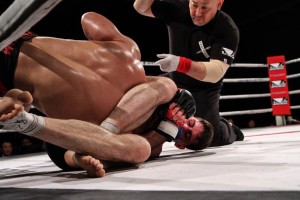
As a fighter you become a utilitarian. Success, failure, sadness or happiness is dependent on one result – victory. Absolute success and abject failure are a consequence of three people’s opinion. However, in the moments before the scores were tallied I couldn’t have cared less about the decision. What Andy had accomplished in the ring that night was a victory of magnificent heights regardless of the callous number system attributed to his name.
Both fighters made their way to the center of the ring. Eyes closed and fists clenched, enduring the uncertainty like a title wave, the decision was read…DRAW. The anticipation met a seemingly anti-climatic conclusion, there was no jubilation, no pounding of chests or devastating remorse – both fighters shook hands and walked away bewildered and dismayed.
Fighting isn’t easy, stay with it long enough and it will bring you face to face with your greatest fears. Physical fears of fatigue, pain and injury are the obvious dangers that occupy the concern of the uninitiated. However, the truly terrifying phobias a pugilist must confront are those of failure, inadequacy, and cowardice. Along with these perils fighting brings truth, it shines an illuminating light on the character of those daring enough to step into the ring. The greatest victory a fighter can earn comes not from the external validation of fame or fortune, but of self mastery. Andy ventured to Japan in search of victory and although that eluded him, along the way he earned something much more valuable.
Precision MMA – Kids martial arts Poughkeepsie
Teaching kids martial arts in Poughkeepsie can be hard at times. The students don’t always have the physical abilities to pull off the moves, their attention is so often elsewhere and they’re especially sensitive. As a result, most of the black belt school owners I know do not teach their kid classes. Instead they delegate the responsibility to an aspiring fighter who is training for free or they hire someone with a greater degree of patience.
I’ve always preferred to get on the mat with my kids. I alternate between teaching triangle chokes and giving speeches about the virtues of doing your homework. The abilities of kids vary greatly, for every student who looks like they might be the next UFC champion there’s another who can’t stop crying after hitting his head on the mat.
I try to make a real investment in my kids, understanding that they’re the future of Precision Mixed martial arts. I hope that I won’t simply improve their kicks and punches, but help them grow up to become better men and women. My right hand man, Chris Stanley is my brother in the struggle. Someone who shares my passion for teaching kids and never lets the smile leave his face, regardless of how chaotic the kids might become. I must confess though, there are difficult days where we question how much of a difference our teaching is making.
Then there are days where I get little gifts like this and I’m reminded why we keep running our kids martial arts classes.
Check out Precision MMA’s kids martial arts classes in Poughkeepsie, NY for 30 Days FREE. Call 845-392-8495 or visit http://www.lagrangemartialarts.com
Florida residents looking for Tampa BJJ check out Tampa Gracie – the best kids martial arts Tampa has to offer
Hello Japan!
Kids today don’t know how good they’ve got it. Yes, the closer I get to 30 the more of a grumpy curmudgeon I become, but in this instance I am one hundred percent correct. Fight master, Ultimate fighter, UFC on Fox, UFC on Fuel, FS1, UFC Unleashed, World Series of Fighting, Bellator, Inside MMA and if you’re really desperate you can always tune to the Spanish station and watch gladitorius del UFC – there’s almost too much MMA these days. Watching elite fighters put their skills on display is an everyday occurrence. However, once upon a time UFC events were pay per view only and often months apart. If you wanted to satiate your MMA desire you had to befriend a Direct TV subscriber and wait for the US broadcast of Pride Fighting Championships. In high school I would have been best friends with Charles Manson if it meant I could watch Kazushi Sakuraba fight Renzo Gracie.
Japanese MMA was special. Pride, Pancrase, K1 and Shooto all had a special flair. They were contested in pristine rings with over the top pageantry and showmanship. Mysterious international talent was coupled with wild rules, scoring and mixed weight super-fights. The silent crowd that appreciated submissions as much as striking was also a welcome alternative to the inebriated “just bleed” crowd that populated American MMA events.
Fighting in Japan was a dream of mine. During my MMA career I scratched off plenty of bucket list items. I fought for Zuffa, made it to the Ultimate Fighter and won a few oversized MMA belts – but I never made it to the Land of the Rising Sun.
Fortune smiled on me though after sparring at the AMA Fight Club on day when my friend Andy Main shared some exciting news. “I’m fighting in Japan” Andy said with his trademark calm demeanor. Without hesitation I told him, “If you fight, I’m there”. Finally, the opportunity to experience Japanese MMA first hand had arrived and in Pancrase no less. Anyone with an appreciation for MMA history knows the esteem place Pancrase holds in the mixed martial arts world – an event that pre-dates the UFC and launched the careers of pioneers like Bas Rutten, the Shamrock brothers, Yuki Kondo and Matt Hume.
Andy Main was slated to take on Hiroki “AB” Aoki as part of Team Nam Phan vs Team Pancrase. Originally a number of fighters were slated to represent Nam Phan, but through a process of attrition Andy became the sole representative for Nam. Andy and Nam knew each other as teammates on season 12 of The Ultimate Fighter. Andy has been the best kept secret in northeast MMA for the past few years. A slick fighter giving top UFC fighters fits in training who ran into a bad streak of illness and injuries. Andy would prep for a fight when shingles, mono, flu or vitamin deficiencies would strike – if there was an illness Andy had it. I used to joke that I knew cancer patients healthier than him. Lately though, it seemed like he had turned a corner. He climbed back into the cage for CFFC and put on a clinic en route to a first round submission victory. His striking had caught up to his jiu-jitsu and he was looking dangerous in all areas.
His opponent was tricky. Aside from having to travel behind enemy lines, the fight was also going to be contested at 155, one weight class above Andy’s normal fighting weight. For the first time he wasn’t going to have the height advantage either as his opponent was long and lean. Experience also played into AB’s favor with him having more than twice as many fights as Andy. If any of this bothered Andy you’d never know it. He put his nose to the grind stone and whenever the topic of Pancrase came up he spoke with an assertive confidence that let me know he expected to walk away with his hand raised.
The only stumbling block seemed to be the fact that the fight would be contested inside a boxing ring as opposed to a cage. Most of our training at AMA Fight Club prepares us for walls and cages rather than ropes. Fortunately, my Hudson Valley MMA gym Precision Mixed Martial Arts has a full sized boxing ring. Andy made weekly trips up to Poughkeepsie, NY to familiarize himself with the ring and pick up some coaching tips from me at the same time. As a student Andy is ideal. He’s receptive to feedback and constructive criticism and makes better mid-round adjustments than almost any fighter I’ve worked with. While coaching him at times I almost felt like I was playing a video game and he was my character.
Finally, camp came to a close and it was time to fly out. I extended my stay longer so I would get some extra training (put the $1,800 plane ticket to good use). After Andy arrived we met in Shinigawa decided it would be good to get a sweat going after being cooped up in a plane for 14 hours. On way to the local Gold’s Gym we got our first taste of Japanese culture shock. Andy is something of a boy scout. He’s a vegetarian; he grew up doing mission work for his local church and runs a business with his little brother. You’re more likely to find him at a dog park than a bar. However, he is covered in tattoos. His most prominent ones are portraits of his mother and father and an inscription reminding him that he is his brother’s keeper. Not exactly skulls and cross bones. However, once the woman behind the counter saw the slightest bit of ink peeking out from the sleeve of his sweat shirt she treated him like he was in the Hell’s Angels. She insisted we leave immediately. After a series of begging and pleading (90% of which was likely lost in translation) we were allowed to stay. Apparently, every Gold’s Gym in Tokyo comes equipped with a fully stocked MMA gym. We got a good workout in and I could feel that in spite of the arduous journey Andy retained his strength.
The following afternoon was open workouts and media day. We met Nam Phan and headed over to a different Gold’s Gym to get some training in. We reviewed some last minute technical strategies and got after it hard. Andy was feeling stronger today and it showed. Once Andy was finished training I got some good flow rolling in with Nam and was impressed. He even showed me a few tips for landing his signature liver shot. It’s too bad we didn’t have more time to train together. The Japanese media was interesting. They were always looking at things from a pro-wrestling angle, trying to stir the pot and get Andy to say something controversial that would fire up the opposition. We were able to find out that everyone had painted Andy as a pure jiu-jitsu fighter. We were excited since striking was a big part of our game plan, we figured the element of surprise would be on our side.
Weight cutting wasn’t going to be an issue. Andy was walking at 155 despite eating regularly. We knew we would be giving up size, but stereotypically the Japanese aren’t big weight cutters so we weren’t too concerned.
The weigh-ins were supposed to be a non-issue, but became more dramatic during the rules meeting. Going into this fight we were under the impression that it would basically be contested under unified rules sans elbows. We quickly found out that we were mistaken. Each time we spoke to someone the rules changed. By the time we were done asking soccer kicks, stomps and knees to a grounded fighter were all legal – it was like old school Pride rules. Fighting for sport is something of a chaotic endeavor. The one thing I try to do as a coach and athlete to mitigate the chaos is to be aware of all the variables and prepare my athletes accordingly. These last minute revelations did not sit well with me. I started going over new strategies and frantically trying to make sense of the new potential dangers we faced in the fight. Andy shared none of my concerns. He looked at me and said “Whatever, it’s a fight”. I wasn’t sure if his resolve was the result of confidence or insanity, but it let me know he was dialed in and nothing was going to change that.
The weigh-ins also saw drama when fellow US fighter Amber Brown struggled to cut the final pounds in order to make her 105 lbs. weight class. Seeing how lean and dry she appeared I wasn’t certain she could do it. Simply walking up a small hill on way to the scale was a tall order for Amber, but there was a lot of resolve in her small frame and she made the weight.
Following some epic meals, sight-seeing and wandering it was game day. Unlike cards in the US which might have 10 or so bouts, Pancrase had stacked 18 fights on the card with Andy being the main event, which meant a whole lot of waiting. As the bout neared closer I noticed a few things that were different in Japan. No one watched me while I wrapped Andy’s hands, a process that is traditionally very closely scrutinized by US athletic commissions. Also, none of the fighters were drug tested. In the US something as pedestrian as a sleeping pill can result in a failed drug test and hefty fines. There was no pre-fight physical or doctor exam. Finally, no Vaseline was applied prior to fights and there were seemingly no cut men in the corners. Many of these rituals are never noted by the casual observer, but for me the absence of these pre-fight traditions made me feel like I was in the Wild West.
After a quick warmup it we stepped into the on-deck circle. Nam and I peeked our heads around the curtain to watch Amber’s fight. We got to know Amber a little in the days prior and were really rooting for her. Things weren’t looking good, she was eating hard leg kicks and had a cut bleeding right over her eye. She rallied in the second round, but was clearly not going to be winning a decision. Time was ticking away with Amber on her back when she threw up a perfect armbar from guard. She put everything into it and scored the submission. Amber’s victory gave us some positive energy to fuel off and I suddenly felt more at ease as the pre-fight promos played for Andy’s fight. There was a long pro-wrestling-esque montage that set the stage for Andy vs AB. Finally Andy’s entrance music played and it was go time. Andy (and his brother Mikey, a fighter himself) walk out to “Some Nights” by Fun. The song is a light hearted sing along track. It helps break some of the tension and anxiety surrounding the imminent battle. AB destroyed this calm ambiance by walking out to the most abrasive screaming death metal I’ve ever heard in my life. The juxtaposition was borderline comical.
Immediately prior to the walkout a new wrinkle immerged when officials told Nam and I that the fight would feature “open scoring”. Meaning that judges would indicate who was winning at the conclusion of each round. I decided not to tell Andy about this new discovery since I didn’t want to break his concentration just prior to fighting.
At long last, the bell sounded and round 1 began. Andy began executing the game plan to a “t”. He marched out, controlled the center and began lacing AB with lightning quick jabs and crosses. Each punch was snapping AB’s head back. Andy was being mindful of his defense keeping his head moving the whole time, being aggressive by not wreck less. AB decided to abandon the striking exchange and moved into the clinch. I could tell he was strong here, but Andy was controlling well with his wizzer. AB made a quick move to Andy’s back and secured hooks for a brief moment, but Andy countered with a Sakuraba like Kimura and turned into the guard. Now ontop Andy worked some ground and pound and looked to pass after thwarting a few upkicks. Taking side control Andy landed some knees to the body before the round closed.
The fight was going perfect, Andy had rocked AB who was now cut and clearly won the round. I told Andy to use and underhook rather than a wizzer to stop AB from coming behind him and to mix some uppercuts into his combinations since AB was looking down to avoid the 1-2’s.
Round 2 began and Andy once again dominated the boxing. He mixed in the uppercuts perfectly and followed them up with huge knees. AB clinched in desperation and Andy pummeled to an underhook and hit a flawless Uchi Mata sending his opponent head over heels crashing to the mat. I thought Andy might just finish the fight here, but AB showed this would be no easy victory by attacking off his back. AB locked in a triangle that had me heart skip a beat, Andy defended well by posturing but found himself in a kimura quickly thereafter. I was confident that the submission wouldn’t be finished, but worried that if the round ended this way they would award it to AB. Andy solved the riddle though and escaped to side control and then immediately mounted. With 15 seconds we told him to pull the trigger and he finished the round raining down strong punches. We were now up 2 rounds to 0.
Going into the 3rd I just wanted Andy to stay out of the clinch. We knew he could knock AB out if he made it a striking battle. I could tell Andy was fatigued, but far from gassed. The third round began much like the prior two with Andy landing clean strikes almost at will. Right as a knockout seemed imminent the ref called a halt to the action to check AB’s cut. Initially I thought this would benefit us since Andy could catch his breath, but the break was so long that it really allowed AB to recover and get back in the fight. AB pushed forward and secured a body lock. He hit a bear hug and landed on top of Andy. As Andy went to shrimp AB took his back and locked in a tight body triangle. Andy defended well, but wasn’t able to move his hips out to escape. Time was on our side though, if we could simply survive the next 2 minutes we would take home a victory. At one point AB had him completely flattened out and things looked bad, but Andy showed his heart and gutted out an escape. To his credit AB landed some shots before Andy secured closed guard, but once he did he immediately threw up a tight armbar, AB defended well and the round came to a close. The open scoring allowed us to breathe a sigh of relief during the announcement – Andy earned the decision.
Nam and I went crazy and ran to congratulate Andy, who was on the verge of throwing up. Fortunately, he was able to hold it together, but he told us he had pulled something in his rib which is why the final round was so dramatic. After a few pictures and autographs we headed back to the locker room victorious.
Following the fight Andy posted this:
“Now the thank you’s! HUGE thank you to my coach and training partner Brian McLaughlin for making the trip to Japan with me and preparing me for this fight. Big thanks to Nam Phan for setting it up. Thanks to everyone at Pancrase for giving me the opportunity. Thank you Coach Mike Constantino and all my teammates at AMA Fight Club, I will be back asap to help you all get ready for your next bouts. Also the guys at Precision MMA and my Instructor Yanni Hronakis for helping me prepare. Thank you to my students and family at Pure MMA you guys don’t realize what you all mean to me. Thank you Alex Kennedy and Melvis Figueroa for helping cover classes while I was away. Thank you my Mom and Pop for the ongoing support. Thank you to my amazing supportive girlfriend Maggie Krol. And thank you to my brother Mikey who keeps me honest and keeps me pushing forward whether he knows it or not. I fight for you all and it makes victory that much sweeter”
Interested in becoming the next Hudson Valley MMA champion? Check out Precision MMA FREE for 30 days call 845-392-8495 or visit http://www.poughkeepsiemixedmartialarts.com
Triangle Chokes!
Here’s a post I did for BJJ.org where I showed all my favorite triangle chokes
Enjoy!
Metamoris II – Better Luck Next Time
Metamoris 1 was the arguably the most exciting professional jiu-jitsu event ever created. An eclectic assortment of different jiu-jitsu approaches – fast and furious, or slow and methodical, intense or playful all pursuing the ultimate goal of submission. Even when no submission occurred there was a sense that each competitor truly left their heart and soul out on the mat. Metamoris 1 was a landmark, torches were passed, rivalries intensified, questions were answered and even more were asked. Every fan of jiu-jitsu awaited the next event with baited breath.
Metamoris 2 was the worst sequel since The Godfather 3, a failure of colossal proportions unimaginable by even the most pessimistic of individuals. After any horrific tragedy the survivors are left with 1 question…why? Some actions are so deranged that no sense can be made of them; such is the case with Brendan Schaub. The only winner in that situation was Matt Mitrione, who gained a huge army of supporters for his UFC on Fox 8 bout vs Schaub. The question was asked by Rener Gracie, if you had to face Cyborg what would you have done differently? The answer is simple, I would have grappled him. If I boxed Flloyd Mayweather and simply fled the ring every time he came close enough to throw a punch I would not be proud of my performance or kid myself into thinking I somehow benefited the sport of boxing. The match was reminiscent of Nate Quarry’s battle against Kalib Starnes.
http://mma-gifs.tumblr.com/post/25934430624/ufc-83-nate-quarry-vs-kalib-starnes
The Schaub abomination aside, the evening was full of people fighting tooth and nail for bottom position, tug of war lapel battles and monotonous half-hearted foot lock attempts. If not for Kron Gracie and Shinya Aoki there would have been no hope whatsoever.
The purpose of this diatribe is not solely to vent frustration (however cathartic that may be), but to hopefully offer some suggestions in the hopes that the greatness of Metamoris 1 may one day be repeated.
#1 – Create a closed perimeter
Rorian Gracie wanted to avoid having contestants flee the ring when he thought up the UFC. The use of a cage wall accomplished this end. While it is understandable that Metamoris wants to differentiate itself from MMA, some sort of physical barrier is necessary. A padded wall of plexi glass hockey rink esque barrier is necessary. Even in the name of safety the change should be made since multiple times fighters were nearly thrown from the mat.
#2 – No judges
Truthfully Metamoris is in many ways a repackaging of Rose Gracie’s “Gracie Nationals” tournaments. Rose got it right, you can’t get your hand raised unless you go for it. You must pursue the submission, period. The most exciting matches of Metamoris 1 were Xande vs Lister and Roger vs Buchecha. However, those matches were made amazing by the fact that the fighters wanted to win so badly that they constantly attacked. Beautiful submissions coupled with amazing escapes occurred as a result of submission being the only path to victory. The finality of a winner is not terribly important in this event since it is not a tournament and not about promoting the fighters as much as promoting the art. Also, in both cases the court of public opinion picked a clear winner anyway. The ironic part of Metamoris 2 was judges were brought in to prevent a draw and the first two matches were judged as a draw. Finally, it may be a moot point since Kron submitted Aoki, but I couldn’t help but feel like the game was rigged against Shinya since two of the judges could not easily remain impartial – JJ Machado is part of Kron’s extended family and Pedro Sauer is his father’s top black belt, it just seemed unfair if you ask me.
#3 – Disqualifications for stalling, timidity or flat out running away
If a competitor turns his back and runs away then they aren’t there to compete. 5 Minutes into the Brendan Schaub / Cyborg match it became apparent that Schaub wasn’t going to engage anywhere, on the feet or the ground. Simply end the contest and move on. I am a fan of a zero tolerance no warning system, just automatic DQ for obvious offensive. This would be the stalling equivalent to the IBJJF’s knee reaping rule. After the first couple of DQ’s the message would be crystal clear, grapple or lose.
#4 – Metamoris Tryouts
The problem is that grapplers are being brought in and the promoters simply cross their fingers and hope that they will be exciting. I believe that elite grapplers should apply be brought in and made to roll for 20 minutes. The ones who get to compete are those who attempt submissions and are exciting to watch. I don’t care if they aren’t the best or if they get tapped out, if they put on a show they get a chance to compete. Also let it be known that those who do not perform will not be invited back.
#5 – Cash Incentives
I don’t know how athletes are compensated at Metamoris, but putting a carrot on a stick would help encourage action. If a competitor knew they would make 50% more if they hit a submission then you can bet they would be hunting for them. The UFC has done this with performance based pay, the problem is MMA is very dangerous so going for a submission and failing can cost you quite a few brain cells. Jiu-Jitsu does not carry the same risks so hopefully competitors will be compelled to pursue a finish in order to fatten their wallets.
Brian McLaughlin is a Brazilian Jiu-Jitsu black belt and head instructor at Precision Mixed Martial Arts in LaGrange, NY a Hudson Valley Martial Arts School
Dutchess County MMA – Triangle Choke for MMA
A blast from the past, here is one of my favorite triangle chokes for MMA competition. This setup works by tightly controlling the distance, allowing you to work into the submission without giving your opponent an opportunity to land a strike. I’m demonstrating this move on none other than UFC veteran Charlie “The Spaniard” Brenneman at the AMA Fight Club. AMA is where I test the MMA techniques I teach in Dutchess County.
This is a move my students use at my Dutchess County MMA gym Precision MMA in LaGrange, NY – for a 30 Day Free Trial call 845-392-8495 or visit http://www.bjjfighter.com
Hudson Valley MMA – The 33% Rule
The 33% Rule
Hudson Valley Training tactics from Brian McLaughlin head Hudson Valley MMA coach at Precision Mixed Martial Arts in LaGrange, NY
Over the last decade I’ve trained at just about every major MMA gym on the east coast from the Hudson Valley to South Florida. I’ve been an instructor, sparring partner or student of fighters ranging from UFC world champions to first time amateurs – I’ve even seen guys go from their first fight in empty middle school gymnasiums to fighting for 6 figures in front of sold out Las Vegas crowds. In this time I’ve seen a myriad of different training approaches and practice routines all with varying levels of effectiveness. Some gyms focused mainly on striking, others were wrestling based and many had a jiu-jitsu approach – but what I’m going to talk about here transcends styles and techniques. This is the training approach that I believe allows an athlete to put themselves in the best position to be successful – the 33% rule.
The old mantra repeated by just about every guru in the business is “train smarter not harder” but what does that really mean? In my estimation this statement highlights the fact that hard work and effort, at a certain point, yield diminishing returns. Biting down on your mouthpiece and pushing yourself 100% certainly has its place in combat sports, but in order to reach the upper echelons of the sport most agree that a higher level of sophistication is warranted. Therefore, training smarter would be defined as the approach which most efficiently leads an athlete towards improvement without injury or burnout.
The specific area of training I am looking to examine deals with sparring (or rolling for you BJJers) partners. The prevailing wisdom is that you’re only as good as your training partners. Therefore, in order to progress a student should work with the highest caliber partners available. The more skilled the sparring partner the better. Admittedly, this was a mindset that I often times fell into. When it was time to train I would avoid the people at or below my level and look to partner up with the killers. However, I noticed that I wasn’t making the strides I expected, despite working with such world class training partners.
My perspective began to change after a conversation I had with my boxing coach. He was complaining that one of his fighters was removed from a training camp for a high profile pro because he was getting the better of the fighter. I was shocked since I was lead to believe that training with people better than yourself was the path to improvement. My coach told me though that in boxing, coaches want a fighter to be very confident going into a fight so that when the moment comes he won’t hesitate to throw his techniques, confidence in training will result in confidence in the fight. They also hone in on specific strategies and techniques they want the fighter executing and if the sparring partner figures out how to avoid them it will throw them off their game. Finally offense is scored more heavily in fight and they would rather their fighter have strong offensive skills to win rather than good defensive skills and survive. Obviously, this approach has some major flaws. Never working with people who can expose your flaws or shortcomings could be a recipe for disaster. However, this was the first time I heard someone explain the benefits of sparring exclusively with lower level partners.
More credence came to this idea when I listened to an interview with Renzo Gracie. The interviewer asked Renzo what it was like having to prepare for major fights when first coming to the US and not having access to elite caliber training partners. Renzo replied that often times that is when a fighter makes their greatest improvements. He pointed out that Roger Gracie excelled the most when he went to London and had very few if any black belts to train with. Renzo rationalized this by explaining that when working with elite partners people often times limit their game and refuse to take chances for fear of getting caught or not being successful. However, when working with lower level partners the student feels comfortable opening their game, exploring new avenues of attack and working out of positions of disadvantage.
Conversely, I worked with many fighters who made great strides after leaving their local gyms and working with more elite competitors. They claimed to have developed the “big fish in a small pond” mentality. The elite competitors pushed them to evolve and fix the holes in their games. Losing in training brought them out of their comfort zone and forced them to take a more critical look at their techniques and strategies.
As an athlete I had experienced both extremes. I had been the big fish as well as the whipping boy. Through a process of trial and error I found what I believe to be the best training approach – the 33% rule. Under this approach 1/3 or your training partners are well below your level. If you’re a pro these are the mid-level amateurs. If you’re an amateur, these are the recreational gym rats. These training partners are nothing short of essential. This is where you build new wrinkled in your offense and work on your worst-case scenarios. For example, when I was first learning how to slip punches my coach told me “have children try to hit you, they wind up so you’ll see it a mile away, but they are fast enough to keep you honest. And if you mess up you’re only getting punched by a 10 year old”. As ridiculous as this sounds it worked wonders for me. Obviously, I wasn’t going to make it as a professional MMA fighter sparring exclusively with children. However, I made sure that 33% of my training was against people that were well below my skill level. These sessions were designed to build confidence and competence in unfamiliar territory. Even when sparring I was using these sessions almost like a form of live drilling. These partners allowed me to build the kinesthetic repetitions necessary to make the movements instinctive. There is some debate about the “magic number” some calling for as many as 10,000 repetitions. I didn’t keep a tally, but I once heard Teddy Atlas talk about training Mike Tyson. He said Cus D’amato instructed him that Tyson was “To do each technique right so many times that he couldn’t do them wrong if he wanted to”. In addition to building repetitions, this 33% would be the portion of my training that would be experimental. Practicing techniques on my weak side, switching to south paw, trying new guard positions for the first time, or attempting a technique I saw online or at a competition all work best against partners well below your abilities. The penalty for imperfection is lower allowing you to feel more comfortable opening up and more confident with each progressive success.
The second tier of training is spent with fighters that are very comparable in skill, but just slightly below your level. This is the next step technical progression. You take the techniques you’ve worked against the lower 33% and test your progress against a more skilled, but still slightly inferior opponent. If you do everything perfect the technique will be a success every time. However, unlike the first group, if the timing or execution is slightly off then your opponent will escape or counter. In addition to cleaning up the mistakes and making the techniques more fluid this is where a student works on contingency plans. What to do if the initial attack is defended, how to sequence attacks together, how to disguise techniques to overcome resistance – this is where these strategies are honed. An important thing to remember here is that these partners are still BELOW your skill level. For a high level black belt, these are the killer brown belts of the world. Some people consider having 2/3 of your training time spent with people below your skill level to be counter-productive. However, there are several advantages that I feel are often overlooked. The first and most obvious (for striking or MMA) is injury prevention. Sparring with elite pros, especially in pre-competition training camps, increases the chances of injury with each session. The next major benefit is more mental than physical. Constantly getting tapped out and dominated wears on a fighter. The ever present self-doubt becomes more pronounced and the satisfaction which comes from successful execution of techniques becomes fleeting. A bad day at training can keep a fighter up at night, building anxiety and stress. This can never be completely avoided, but certainly minimized by the 33% rule. Finally, a fighter does not grow and evolve when they are constantly put in a defensive shell. If keeping one’s head above water is an arduous fight then you can bet they aren’t going to learn any new strokes. When working against a group of killers the struggle for survival supersedes the need to evolve. I have seen training camps where fighters work exclusively with partners better than them. In some cases these elite partners are even rotating in fresh against a tired inferior fighter. Generally, this makes one very good at tapping out and taking shots, but not much else.
The final tiers of training partners are those that are better than you. This is where your defense and survival skills get put to the test. This is where you swim in the deep end of the ocean. You should be getting tapped out, taken down, hit and at times dominated. This 33% should point out where you concentrate your efforts with the other 66% of your partners. If the top tier can take you down at will then you need to implement new or sharpen your existing strategies and techniques for takedown defense with people you are better than. Then test your progress with people who are better than you. This 33% stops fighters from becoming cocky or complacent. Ideally, it shows them how high the mountain of success is and inspires them to work harder.
This is the tier that most people misuse. For example, I had a former coach enthusiastically call me to tell me about a fighter of his who would be the next UFC champion. He told me proudly, “No one in training can stop his takedown and no one can take his punch”. I knew after that statement that he was not training smart. There should always be someone who can best you somewhere. Sure enough the much heralded fighter never climbed to the heights prophesized. Conversely, I’ve seen amateurs who refuse to work with anyone that is not a high level pro. These well intentioned up and comers typically become mediocre and rarely obtain their lofty goals.
There are two places where the 33% rule does not necessarily apply. The first is for someone completely new. In this instance everyone will be better and it therefore doesn’t necessarily make practical sense to break training partners into tiers. The second group includes those who are among the very best in the world in a particular discipline. In this case, nearly everyone falls into the first group. To reach the top or stay on top it may be necessary to almost exclusively work with elite training partners.
In order to maximize the effectiveness of the 33% rule you must know where your partners stack up and train with them accordingly. For example, if you decide to focus your training on armbars. The first 33% is where you will build your reps, make the steps of the armbar second nature and automatic. You can also work on your weak side armbar and experiment with exotic entries and finishes. The second tier you will work on breaking the grip, overcoming stacking and dealing with guys ripping their arms out. You’ll work on hitting armbars off sweeps and distracting opponents with other submissions or disguising your setups. The final group you’ll work on follow up moves and put yourself under the microscope. How to maintain guard after they roll out of the armbar, how to remain on top if the mounted armbar fails. Also examine why you aren’t successful with moves that work against the other 2 groups. Is it an issue with your grip, your timing, or your hips? If you are with someone better than you it doesn’t make sense to try an exotic armbar on your weak side. If you are with someone inferior to you it will be difficult to analyze where the holes in your attacks are. Focused training will lead to the greatest success with the fewest headaches.
The 33% rule is something I’ve put into practice at my Hudson Valley MMA gym, Precision MMA.
Looking to train Hudson Valley MMA? Precision Mixed Martial Arts offers elite Mixed Martial Arts training in the Hudson Valley. Call 845-392-8495 or visit http://www.poughkeepsiemixedmartialarts.com
- 1
- 2

